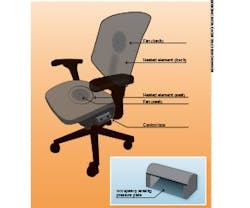Will a Broader Range of Indoor Temps Silence Occupant Complaints?
According to ASHRAE Standard 55: Thermal Environmental Conditions for Human Occupancy, no more than 20% of a building’s occupants should be dissatisfied with indoor temperatures in their building. Would at least 80% of the humans in your building report that they are satisfied?
If not, you have a lot of company. One study found that 41% of workers are dissatisfied with their thermal environment. A major culprit may be thermal boredom, according to researchers at the Center for the Built Environment (CBE) at the University of California.
In a paper entitled “Evolving Opportunities for Providing Thermal Comfort,” the researchers describe the futility of trying to design indoor environments to static, uniform conditions with no perceptible air movement. They liken the resulting monotony to eating the same foods at every meal and experiencing unchanging light and weather conditions. Not only do individuals have varying preferences, but also those preferences change through the day. Different activities – typing, reading, making phone calls that boil the blood – affect occupants’ sense of what is comfortable.
This one-temperature-fits-all approach also incurs a huge energy penalty. The solution, the researchers believe, is to provide more individual control with personal devices. In turn, that would allow FMs to let setpoints float over wider and more energy-efficient levels and alleviate thermal boredom.
Measuring the Impact of Personal Comfort Systems
The CBE is developing so-called personal control systems (PCS) designed to reduce energy and improve individual thermal comfort satisfaction. The PCS devices allow occupants to adjust thermal conditions to their personal preferences over a wider range of ambient temperatures. In this sense they function much like task lighting, which the individual can control at the workspace while ambient lighting levels are reduced.
The first generation of devices involved a desktop fan using 1-4 watts and an underdesk footwarmer using up to 30 watts. Both have integrated occupancy sensors that turn the devices off when the workspace is not in use. They also have USB ports for cables that transmit use patterns to the central system.
Field study showed that the footwarmers were effective over the winter heating season, allowing ambient temperature settings to be reduced by 4 degrees (from 70 to 66 F.) without decreasing thermal comfort. The average additional 20 watts consumed by each footwarmer were offset by a 500-watt reduction per occupant in HVAC consumption. A similar comfort correction of 4 degrees was recorded during the summer cooling season.
The second-generation PCS is a chair with a paired fan and heating element in the chair back and another pair in the seat. A control box with a knob is located on the side of the seat. The chair consumes 3.6 watts in cooling mode and 14 watts in heating mode. Its rechargeable batteries are recharged at night. Preliminary results suggest that the chair is more effective than the fan/footwarmer combination, although more testing is needed.
The research suggests that people favor a perceptible level of air movement when they feel warm or cool. The researchers theorize that occupants may like the air movement for its freshening effect, not only its thermal compensation.
